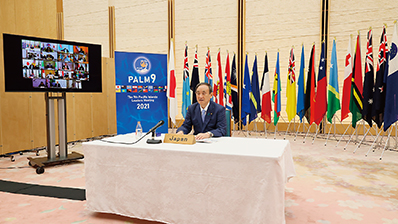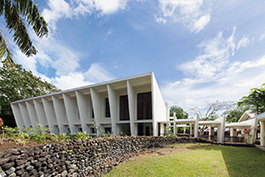ODA Topics 6
Holding PALM9 and Japan’s Development Cooperation toward the Pacific Region

Then Prime Minister Suga attending PALM9 (Photo: Cabinet Public Affairs Office of the Government of Japan)

The Pacific Climate Change Centre in Samoa, a hub for human resources development for climate change measures (Photo: JICA)
On July 2, 2021, the Ninth Pacific Islands Leaders Meeting (PALM9) was held via video conference. PALM is a summit meeting that has been held every three years since 1997. It involves candid exchanges of views at the summit level on various issues faced by the Pacific Island countries (PICs), with the aims of contributing to the stability and prosperity of the region and strengthening the partnership between Japan and the PICs. PALM9 was co-chaired by Japan and Tuvalu, and was attended by 14 island countries across the Pacific Ocean plus Australia, New Zealand, and others, totaling 17 countries and two regions.*1
At PALM9, then Prime Minister Suga announced “Japan’s Pacific Bond (KIZUNA) Policy,” which would further strengthen cooperation between Japan and the PICs. Japan works toward realizing a “Free and Open Indo-Pacific (FOIP)” and, in its relations with the PICs, Japan has been taking an “All-Japan” approach to strengthen its initiatives, such as establishing the Interagency Committee for Promoting Cooperation with Pacific Island Countries in 2019 as a working-level meeting among the relevant ministries. Japan named these efforts “Japan’s Pacific Bond (KIZUNA) Policy.”
Under this policy, the PALM Leaders set out the following five priority areas for the next three years: (i) COVID-19 Response and Recovery, (ii) Sustainable Oceans based on the Rule of Law, (iii) Climate Change and Disaster Resilience, (iv) Strengthening Foundation for Sustainable and Resilient Economic Development, and (v) People-to-People Exchanges and Human Resource Development. They also announced commitments such as people-to-people exchanges and human resource development for over 5,500 people. Moreover, the concrete initiatives that Japan would work on together with the PICs were compiled as the Joint Action Plan, an annexed document of the PALM9 Leaders Declaration. The PICs recognized the significant role that PALM has played so far and expressed their appreciation for the accomplishment of Japan’s commitment to the PALM8 and the new commitments regarding the five priority areas.
Over the next three years, Japan will provide assistance according to the needs of each country, with a focus on the five priority areas. For example, with regard to (i) COVID-19 Response and Recovery, Japan will continue to support distributing, managing, and administering inoculation of COVID-19 vaccinations in cooperation with relevant countries and institutions*2 to improve fragile medical systems with few doctors and hospital beds, as well as to provide various support such as developing medical facilities, providing quality medical equipment, and building capacity for health and medical workers. Japan provides COVID-19 vaccines through the COVAX Facility while coordinating with other donor countries. In the area of (iii) Climate Change and Disaster Resilience, the PICs are prone to suffering natural disasters such as cyclones and are susceptible to the impact of climate change. Therefore, Japan will continue to provide training at the Pacific Climate Change Centre established as a hub for the development of human resources associated with climate change in 2019 in Samoa with Japanese assistance. Japan will also work on developing disaster-resilient infrastructure, providing assorted equipment for disaster risk reduction, and other initiatives. Also, regarding (v) People-to-People Exchanges and Human Resource Development, Japan will carry out support for human resource development, including technical cooperation and training programs, which are one of Japan’s strengths, such as accepting young government officials from the PICs who will be potential leaders in the future as interns at Japanese government institutions.
As a good partner of the PICs, Japan will support their self-reliant and sustainable development through such assistance.
*1 Participating countries and regions were Japan, 14 island countries (Tuvalu, Cook, Fiji, Kiribati, the Marshall, Micronesia, Nauru, Niue, Palau, Papua New Guinea, Samoa, Solomon Islands, Tonga, Vanuatu), Australia, New Zealand, New Caledonia, and French Polynesia.
*2 Australia, New Zealand, the United States, the Asian Development Bank (ADB), World Health Organization (WHO), the COVAX Facility, etc.
